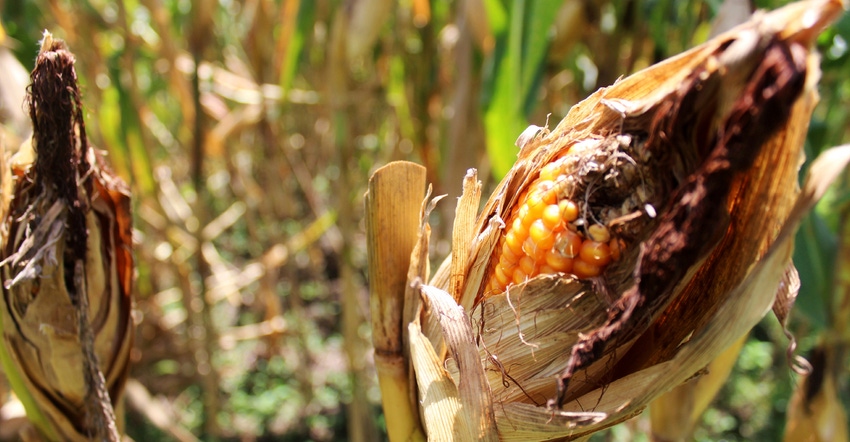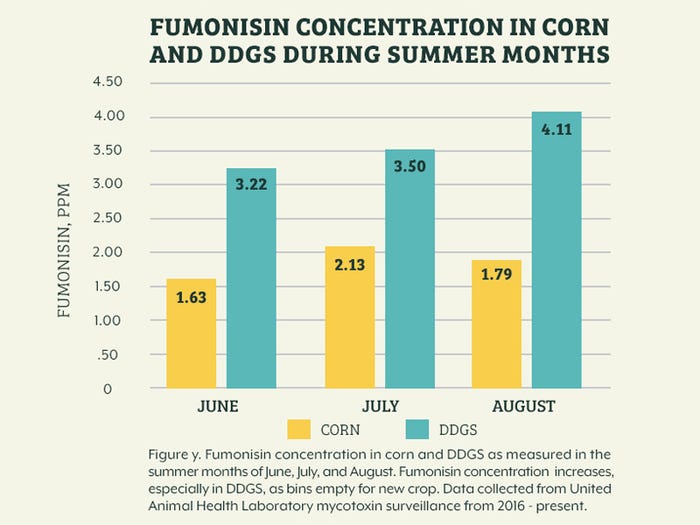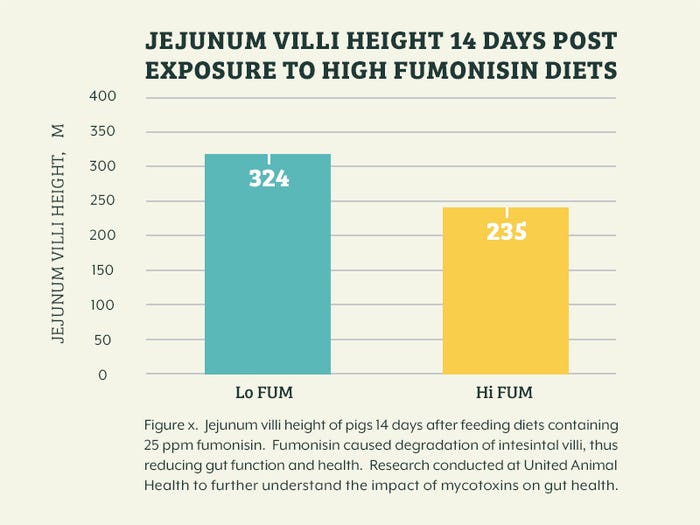In late summer, heat stress combined with mycotoxins negatively impact gut health and create enteric turmoil that will result in performance losses.
August 1, 2020

Sponsored Content
By Adrienne Woodward Ph.D., MBA, United Animal Health research scientist
The concept of achieving a healthy gut is like hitting a moving target. There are a number of insults that can damage intestinal integrity, and this seems to be especially evident in the heat of late summer and early fall months, when performance often lags, and seasonal enteric pathogens thrive.
While increased diarrhea and incidence of E. coli may be found in barns during this time, causes of these enteric challenges may not be due to just one factor. In this article, we will explore how a combination of heat stress and mycotoxins produced during grain storage may contribute to increased pathogenic load for the animal in late-summer months.
Heat stress
Heat stress occurs when a pig cannot regulate its internal temperature, thus causing decreases in performance and health, and even death in severe cases. Heat stress typically occurs during the summer months, when pigs are subject to both high temperatures and humidity. It can take as little as two hours for the intestine to show the effects of heat stress, as the body shunts blood away from the gut and toward extremities.
As blood gets drawn away from the intestine, the gut barrier begins to degrade, and intestinal integrity is lost. This can expose the pig to multiple additional insults, including release of endotoxins from the gut microbial population1. If the pig is continuously exposed to high heat and humidity without the ability to regulate body temperatures back to the norm, the intestine will continue to degrade, paving the way for opportunistic pathogens, such as E. coli, to take hold and colonize.

Mycotoxins
Mycotoxins are toxic substances produced by fungi that are present on multiple grain products common in swine diets. Mycotoxins can form at any point during the grain lifecycle — during growth, harvest or even storage. In summer, as bins begin to empty to prepare for the new crop, the prevalence of mycotoxins, often associated with cracked or damaged grains (fines) found at cleanout, can increase.
Most mycotoxins lead to a decrease in performance; however, fumonisin in particular is the most dangerous to intestinal integrity. Fumonisin has a very low absorptive capacity, meaning that it is only partially absorbed from the intestinal tract. Instead, fumonisin travels largely unchanged throughout the gut, continuously causing damage to the epithelial lining. In fact, fumonisin has been linked to an increase in intestinal E. coli colonization at low (5-8 parts per million) dietary levels2. As grain bins empty and fumonisin potential increases, the prevalence of E. coli in pigs could be increased.

Heat stress + mycotoxins = pathogen playground
Toward the end of summer, the combination of heat stress and mycotoxins can result in significant impacts to gut health and integrity, namely the destruction of the intestinal lining. Once the damage occurs, opportunistic pathogens are going to find a way to proliferate and colonize, creating enteric turmoil that will result in performance losses and increases in diarrhea. Therefore, the looseness present in pigs during this time may not be due to one cause, but a combination of issues, including high heat and feedstuffs contaminated with mycotoxins.
Understanding the source of enteric issues, whether they be from heat or mycotoxins or a combination of both, will help lead to a solution for diarrhea and regaining performance during late summer.
References
1 Gabler, N. K., Koltes, D., Schaumberger, S., Murugesan, G. R., and Reisinger, N. 2018. Diurnal heat stress reduces pig intestinal integrity and increases endotoxin translocation. Transl. Anim. Sci. 2:1-10.
2 Oswald, I. P., Desautels, C., Laffitte, J., Fournout, S., Peres, S. Y., Odin, M., Le Bars, P., Le Bars, J., and Fairbrother, J. M. 2003. Mycotoxin fumonisin B1 increases intestinal colonization by pathogenic Escherichia coli in pigs. App. Env. Microbiology. 69(10): 5870-5874.
About the Author(s)
You May Also Like


.png?width=300&auto=webp&quality=80&disable=upscale)
